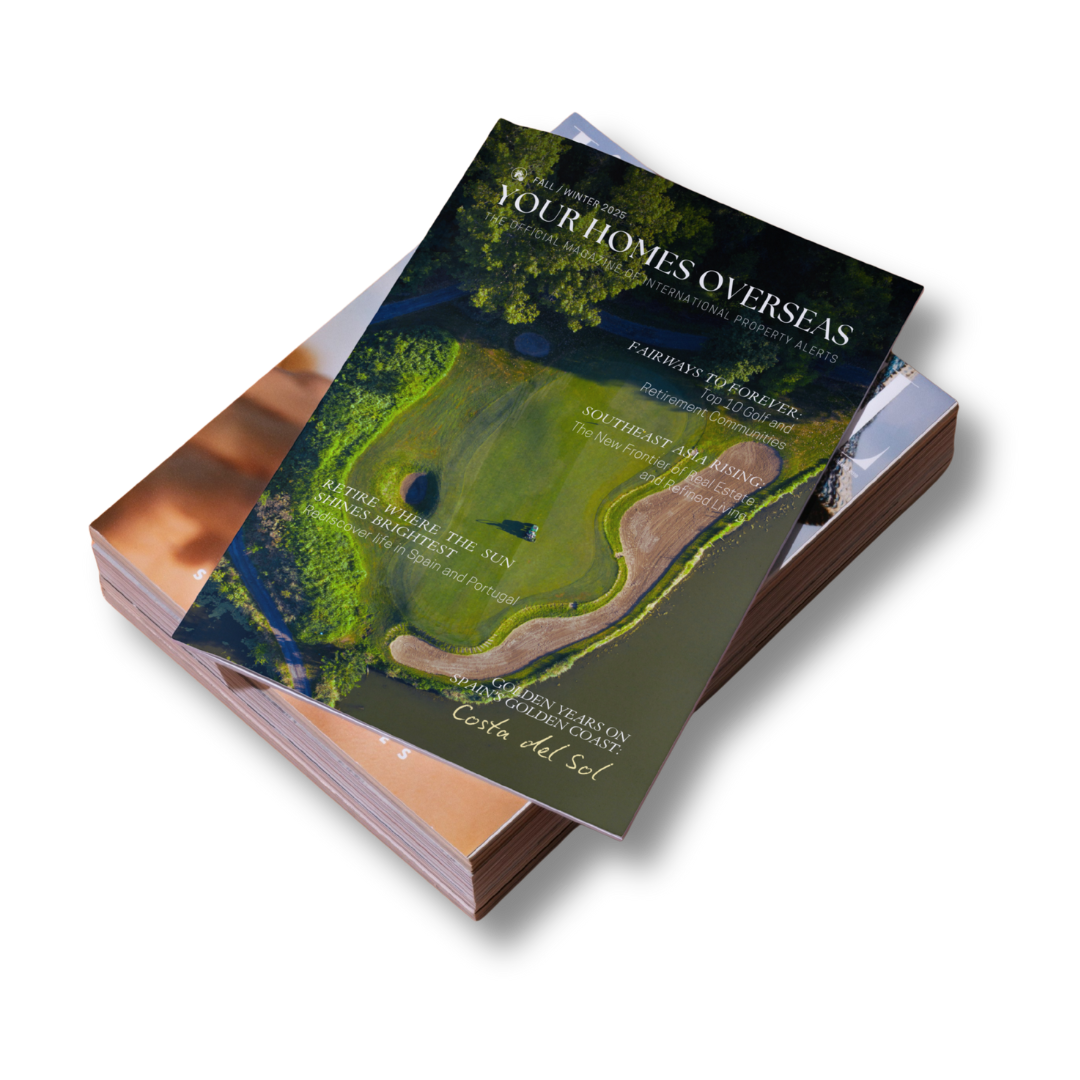
Get Your Free 1st Issue
Your Homes Overseas Magazine!
Discover the best destinations, property tips, and lifestyle insights from around the world.
GET YOUR FREE MAGAZINE HERE!

Discover the best destinations, property tips, and lifestyle insights from around the world.
GET YOUR FREE MAGAZINE HERE!

The history of real estate is the story of how people started buying, selling, and owning land and homes. Long ago, people only owned land to grow food or build shelter. Over time, the idea of owning property became more important. As a result, it changed the way people lived and worked. Today, real estate is a huge part of our economy, and everyone wants to own property.
The history of real estate traces the evolution of property ownership from ancient civilizations to modern times. Initially, land was controlled by rulers and used for farming. Over time, the concept of private ownership grew, leading to the development of cities, suburbs, and the global real estate market we know today.
Understanding the history of real estate helps us see why things are the way they are now. How people bought and sold property has changed a lot. In the past, property was mostly owned by the rich or by governments. Now, many people can own a home. Therefore, if you want to learn more about real estate, you can always trust International Property Alerts for guidance.

The history of real estate begins long before the modern world. In ancient civilizations, land was essential for survival. People started to value and control property, which laid the foundation for what we know today.
In ancient times, land ownership was rare. The history of real estate shows that only rulers or tribes could own land. For example, in ancient Egypt, the Pharaohs controlled large areas of land. They used this land to grow crops and build temples. The land also became a symbol of wealth and power.
As civilizations grew, the idea of property rights started to form. The first known property transactions happened in Mesopotamia, around 4,000 years ago. People began to trade land and homes. The history of real estate shows that the idea of owning land slowly spread to different parts of the world. So over time, even common people started to buy and sell small pieces of land.
The first real estate deals were very simple. They usually involved exchanging goods like crops or livestock for land. So as time went on, these transactions became more formal. In ancient Rome, the government made laws that helped people buy and sell land safely. These laws helped set up the rules for real estate transactions, some of which we still use today.
The history of real estate teaches us that land ownership started as a way to control resources. Over time, it grew into something more complex, shaping societies and economies all over the world. For example, real estate in Mexico has played a significant role in the country’s development, as people increasingly invest in both residential and commercial properties, driving growth in various regions.
The history of real estate took an important turn during the Middle Ages. During this time, land was the most valuable thing people could own. That is to say, it was controlled by monarchs, kings, and lords.
In the Middle Ages, the feudal system controlled the land. Kings gave large pieces of land to lords and nobles. In return, the lords promised to support the king in battle. The lords then gave smaller pieces of land to knights and peasants. The real estate history of a property in this system was tied to these promises. It was a way for the king to keep his power and control over the people.
Land was the most important source of wealth and power during the feudal system. Those who owned the land had control over the people who worked it. The lords and kings who owned the land became very powerful. They had money and influence because they controlled what was grown, hunted, and used. People who worked the land, called peasants, didn’t own any property. They lived on the land but didn’t have the right to sell it.
Over time, the history of real estate changed. As trade and commerce grew, the middle class began to rise. Towns and cities started to grow, and some middle-class people started to buy land or property. They didn’t have the wealth of the lords, but they could still own homes or businesses. This was the beginning of modern real estate ownership for people outside the upper class.
The Middle Ages laid the groundwork for land ownership to become more common. It also showed that land was not just for the rich. Over time, more and more people started to see the value in owning property.

The history of real estate changed a lot during the Industrial Revolution. This time, starting in the late 1700s, made cities grow bigger. It also brought lots of people to towns. As a result, this had a big impact on real estate, or how we use and own land and buildings.
The Industrial Revolution made everything happen fast. Factories were built everywhere, and more people needed jobs. So, they moved from the countryside to the cities. The history of real estate shows how this caused a big need for homes and places to work. Cities grew quickly, and there wasn’t enough space for everyone.
As more people moved to cities, they needed somewhere to live and work. The history of real estate shows that the demand for buildings increased a lot. People needed residential properties, like houses and apartments. Businesses needed commercial properties, like shops and offices — a trend that continues to shape international property markets today.
The Industrial Revolution caused cities to change quickly. More people needed places to live and work, and that’s why the real estate market grew so fast. Today, we still feel the effects of this growth in cities.
The history of real estate in the early 20th century was shaped by a huge shift. After the Industrial Revolution, many people moved to cities for jobs. Over time, more and more people wanted to live outside of crowded cities, leading to the rise of suburbs.
As cities got larger, people began to look for quieter, safer places to live. Suburbs became the perfect solution. The history of real estate shows how homes were built in the suburbs for families who wanted more space. People liked having their own homes with yards, and this changed the way real estate was used.
The demand for homes in the suburbs grew quickly. This was part of the real estate history of a property becoming more about family homes, not just businesses. More people could now own their own homes, a big change from the past when only the wealthy could afford land.
The rise of the suburbs helped shape today’s real estate market. It changed how people thought about owning homes and how cities grew. People started to see suburbs as a place to build a comfortable life.
After World War II, the history of real estate saw a major change. The world rebuilt, and many people started buying homes. In other words, this period marked the start of a real estate boom that would shape modern cities and neighborhoods.
In the years following the war, many people wanted their own homes. The demand for housing grew quickly. Therefore, the history of real estate shows how families, especially in the U.S., began to buy homes in large numbers. Also, new suburbs were built, and there was a huge increase in residential real estate.
Along with the growth in residential homes, there was also a boom in commercial real estate. The economy grew, and businesses needed new office buildings, factories, and shopping centers. For example, real estate in the Philippines saw a significant rise in commercial properties, with demand for office spaces and retail centers increasing in cities like Manila. As more people began to work in bigger cities, the need for office space became even more apparent.
This period of growth after World War II had a lasting impact on real estate. It changed how people lived and worked. The growth of suburbs and cities set the stage for the real estate market as we know it today. The history of real estate shows how this boom affected the economy and property ownership.

The history of real estate shows how important property is for the global economy. Therefore, property ownership has a big effect on people’s wealth and the way economies grow.
Owning property has always been one of the best ways to build wealth. The history of real estate shows how people and families have gained money by owning homes and land. This is because land and buildings can increase in value over time. So when you own a home, it can grow in value, meaning you can sell it for more than you paid.
Investing in real estate has been a way for many people to earn money for centuries. People buy property, rent it out, and collect money from tenants. That is to say, this money comes in the form of rent. Over time, the value of the property can increase, so investors can sell it for a profit. Many also choose to invest in international real estate, expanding their portfolios across different countries and benefiting from the growth in global property markets.
The real estate history of a property shows that owning or investing in property has always been a strong way to grow wealth. Today, real estate still plays a major role in shaping the global economy. People use property to make money, build wealth, and secure their future.
The history of real estate shows how land and property have shaped our lives. From ancient times to smart homes, each step helped build today’s property market. People learned, built, and grew through owning land.
Today, we still see how the past affects real estate. Property ownership and new technology keep changing how we buy, sell, and invest. The history of real estate helps us understand where we came from and where we’re going. If you want help with your property goals, contact us at International Property Alerts. We’re here to guide you every step of the way.
The history of real estate began with the need for land to grow food and build shelter. So over time, land ownership became a symbol of power and wealth. Ancient civilizations, like Egypt and Mesopotamia, set the stage for the modern real estate market.
The Industrial Revolution led to rapid urbanization, which caused cities to grow quickly. Factories were built, and more people moved to cities for work. As a result, this increased the demand for both residential homes and commercial properties, greatly shaping the history of real estate.
During the Middle Ages, the real estate history of a property was often tied to feudal systems, where land was controlled by monarchs, lords, and nobles. As a result, the concept of property ownership was restricted, and only the wealthy or those with land grants could own property.
In the early 20th century, people began to move away from crowded cities to the suburbs, seeking more space and a quieter lifestyle. Therefore, this led to a surge in suburban real estate development, marking a shift in the history of real estate towards more family-oriented, residential properties.
Technology has transformed the history of real estate by making the buying, selling, and managing of property much easier. So, from online property listings to virtual tours and e-signatures, digital tools have streamlined the real estate process, making it faster and more accessible.
About International Property Alerts
International Property Alerts is a premier global platform connecting real estate investors with handpicked opportunities in emerging and lifestyle-driven markets. Through curated listings, expert guidance, and market insights, we help buyers make confident property decisions worldwide.
Media Contact:

Phone: +4477 1923 8132
📱 WhatsApp: +63927 073 9530
Email: office@internationalpropertyalerts.com

Elle Resort & Beach Club offers a rare chance to own property in one of the most desirable coastal locations. With limited units, strong capital growth potential, and unmatched resort facilities, this is your opportunity to secure a beachfront lifestyle with long-term value.

Thinking about buying property abroad? Don’t make the move without the right knowledge. Our Free Buyers Guide gives you essential insights on legal steps, taxes, financing, and the best markets worldwide. Trusted by international buyers and investors.

Wake up to bright, spacious living with stunning views and modern comforts. Whether for family living, retirement, or a stylish retreat, Sudara Residences makes your dream home a reality

Discover curated property listings with IPS—residential, commercial, villas, land—and get expert guidance through every step.
BONUS: FREE Cambodia Buyer’s Guide

High visibility. Targeted audience. Maximum exposure. Rent this space and let your brand shine.

Get your properties in front of high-intent investors. Showcase your listings to buyers worldwide.

From pounds to pesos, yen to dollars. ⚡ Quick. Easy. Secure.
Compare listings
ComparePlease enter your username or email address. You will receive a link to create a new password via email.